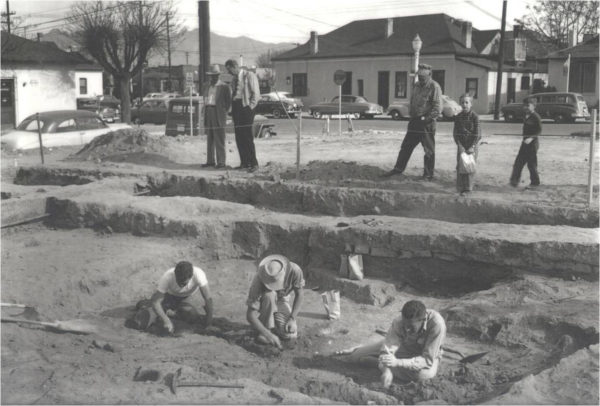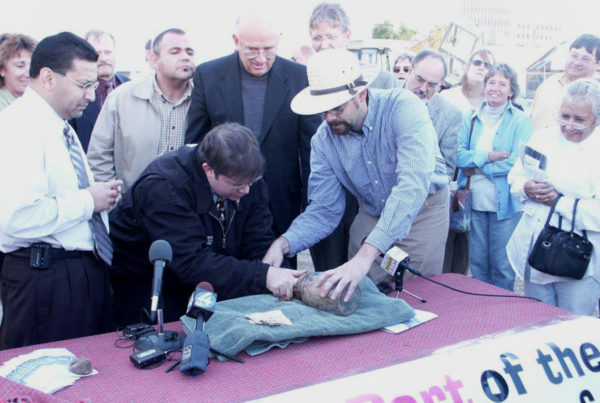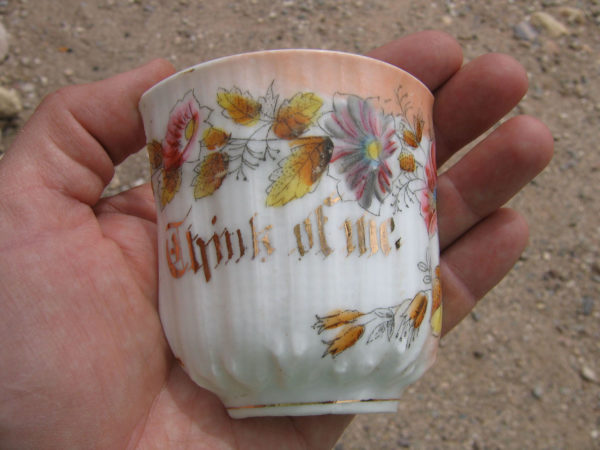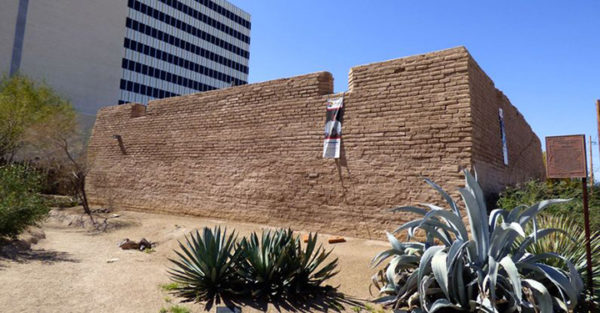
Think of Me.
Today marks historical archaeologist Homer Thiel’s 25th anniversary at Desert Archaeology. In a special blog entry, he thinks back to two key finds that encapsulate his career.
The phone in my Tempe apartment rang on July 10th, 1992. “Hello, this is Bill Doelle of Desert Archaeology in Tucson…” Bill was looking for someone to analyze artifacts from the Hotel Catalina site in Tucson and had been told by Dave Abbott that there was this graduate student at Arizona State University who was interested in the historic period. That phone call was the beginning of a career at Desert Archaeology that is now 25 years old.
People often ask me, “What is the best thing you have found?” After 25 years, that is really difficult to answer because I have had the privilege of working at a wide variety of archaeological sites and conducted research in many archives. And I have found many interesting things.
Back in 2005 I was running excavations in a former parking lot at the southwest corner of North Church Avenue and West Washington Street in Tucson. This corner was slated to be the site of a recreated corner of the Presidio San Agustín del Tucson, the Spanish and Mexican period fortress where about 100 soldiers and 300 to 400 family members and civilians had once lived between 1776 and 1856.
This was our second stage of fieldwork. The first, in 2000-2001, had shown that enough intact features were present beneath a parking lot to allow for the accurate recreation of an adobe tower, wall, and other features. Our second stage of fieldwork involved clearing areas that would be impacted by the construction work.

The Presidio site excavations in 2005. The stone foundations of the Dodge Boarding House are visible on the right side (photograph by Robert Ciaccio).
Even though I was running the project, I still sometimes liked to do a little digging. One day towards the end of lunch hour I climbed into a trench where we had found a large soil mining pit, dug to obtain dirt to build the adobe walls of the two-story Dodge Boarding House in 1897 or 1898 and then filled with trash into the early 1900s. As I scraped dirt away, a fragment of a porcelain cup appeared. I could see it had a hand-painted design on it, so I carefully brushed some of the dirt off. Written in gilt letters were the words “Think of Me.”
It is not often that archaeologists get a direct message from the past, in this case someone who had once lived in the boarding house asking to be remembered. But remarkably, this was the second time this had happened at the site.
Back in 2000, we began our work by digging 13 parking spaces within the lot in an attempt to see whether archaeology had been preserved under the 46-year-old asphalt. The Dodge Boarding House had been torn down in 1954 and a local history enthusiast, George Chambers, organized an archaeology dig before the area was paved. He thought that the corner of the Spanish fort was likely present, and soon University of Arizona archaeologists found a three-foot-wide adobe wall, apparently from the fort. However, they also found a prehistoric Hohokam pit structure, and that quickly diverted their attention as they focused on uncovering it. Chambers tried to get the City of Tucson interested in the site, but was unsuccessful. The location was backfilled on December 28, 1954, and then paved.

Archaeologists uncover a Hohokam pit structure, with the adobe wall of the Presidio tower behind them, in December 1954 (photograph courtesy Arizona State Museum).
We had decided to uncover the pit structure and the adjacent thick adobe wall in two of our parking lot units in order to re-map them. Archaeologist Avi Buckles asked me, ‘Are we going to find a time capsule?” I laughed and told him that archaeologists never find time capsules.
And of course an hour later Avi was digging out a pit cutting into the floor of the house and found a large pickle jar. He said, “There is an envelope inside with the words Tucson Newspaper Companies.” This was where George Chambers had worked. Avi had found a time capsule
Two days later a crowd watched as Tucson Mayor Bob Walkup carefully pulled the damp envelope out of the bottle and two city councilmen read the Chambers’ letter, “To WHOMEVER MAY BE AS MUCH CONCERNED AS I: AND MORE SUCCESSFUL IN AROUSING PUBLIC INTEREST IN THE IMPORTANCE OF PRESERVING THIS HISTORIC SITE.” The jar also contained the December 28, 1954 issue of the Arizona Daily Star and a penny, nickel, and dime from 1954.

Councilmember Jose Ibarra, Peter Rico, Mayor Robert Walkup, archaeologist Homer Thiel, and Irma Moreno watch as Councilmember Fred Ronstadt attempts to coax the newspaper from the time capsule (it was too water-swollen to come out) (photograph by Robert Ciaccio).
George Chambers’ s plea came to fruition in 2007 with the opening of the Presidio San Agustín del Tucson Park. Visitors can see the rebuilt corner of the fortress and a house from that period, a 2,000-year-old pit structure, and the restored 1860s-1870s Siquerios-Jácome house with exhibits and a gift shop. Managed by the Tucson Presidio Trust (I’m currently that group’s president), the park allows visitors to “Explore Tucson’s History.”
I have found many interesting things in the last 25 years working for Desert Archaeology, but these two artifacts asking me to think about the past and to preserve it for the future have summed up my philosophy about archaeology.
You can see the “Think of Me” cup on exhibit there, while the time capsule jar is on display at the Arizona Historical Society.



